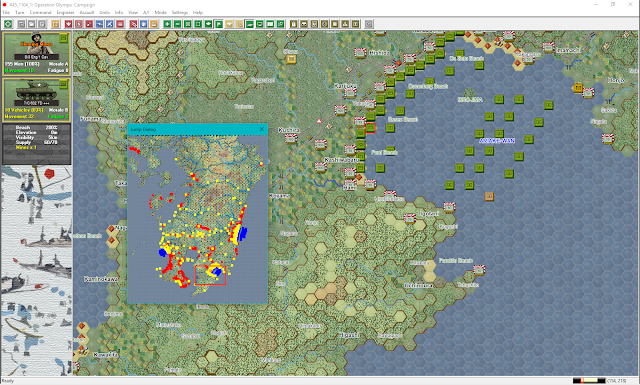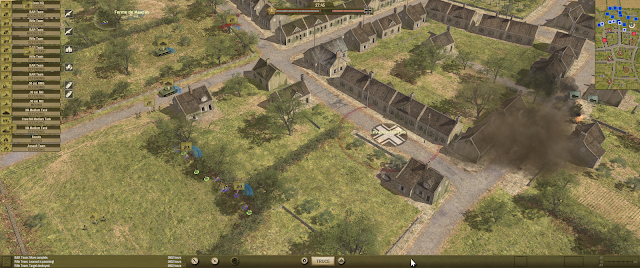Panzer campaigns Japan '45
by
John Tiller Software
It is fall of the year 1945 and the Allies (United States) are determined to invade Japan. This is an alternate universe where there has been no Atom Bomb, and Japan is still refusing to unconditionally surrender. The U.S. has designed a plan to invade Japan called 'Operation Downfall'. The first part of the plan is 'Operation Olympic', the invasion of the island of Kyushu. That the U.S. troops will face fanatical resistance is a tremendous understatement. Even women and children have been semi-trained to fling the invader back into the Sea. The U.S. certainly has the firepower to inflict tremendous casualties on the Japanese people, but does it have the resolve to face the amount of casualties that will be inflicted upon it? Panzer Campaign Japan 1945 gives you the chance to game the outcome of Operation Olympic.

John Tiller Software has been dishing out meat and potatoes to wargamers for twenty years. Yes, some of their games are that old. It is also true that the very core of the game is still the same. I can hear the groans now. "Oh this makes my eyes bleed",
"A computer game is old in six months", "How do you expect us to play the same old thing". I not only expect you to play it, but also to like it. We play boardgames that make these games seem like whipper snappers. They have been continuously updated down through the years to make the games still great, and not just ones that are played for nostalgia. The latest round of updates have definitely brought the games visually and play wise right back at the center of computer wargaming.
These are the features of the game from the horses mouth:
Game scale is 1 hex = 1 km, 1 turn = 2 hours, with battalion and company size units.
44 Scenarios covering all sizes and situations, including specialized versions for both head to head play and vs. the computer AI.
The master map covers most of the island of Kyushu (87,720 hexes) where Operation Olympic would have taken place.
The order of battle file covers all of the forces that would have taken part in the campaign.
Order-of-Battle and Scenario Editors which allow players to customize the game.
Sub-map feature allows the main map to be "chopped" up into smaller segments for custom scenario creation.
All new images for unit art on both sides, including guns and vehicles covering all of the forces of the Allied and Japanese armies involved in the operation.
Design notes which cover or include the production of the game, campaign notes, sources and a scenario list.
All new game graphics including terrain, in game counters and 2D & 3D units as well as the toolbar icons.
All new sounds.
Japan '45 provides multiple play options including play against the computer AI, Play by E-mail (PBEM), LAN Internet "live" play, and two player hot seat.
These are the scenarios:
Panzer Campaigns: Japan '45 Operation Olympic covers the entire campaign to take southern Kyushu from November to December 1945:
The landing on Tanega-Shima - 1 thru 3 November 1945
The Invasion Phase - 4 thru 6 November 1945
The Breakout Phase - 7 thru 10 Novemeber 1945
The Linkup Phase - 14 thru 17 November 1945
The Final Phase - 19 thru 24 November 1945
Japanese Counterattacks - Mid December 1945
The 44 scenarios range from small actions such as the 6-turn, second day fighting at Ariake Bay to the super-large 283 turn "Take Kyushu" scenario. The wide variety of scenario length and size will give the players a stiff challenge! Weather conditions range from normal to mud. The terrain on Kyushu can be as much of an obstacle to victory as the enemy forces.

The game is not for the faint of heart or for someone who is looking for a Panzer General fix. This is a game where you will study the map longer than a Chess board before you make your move. These games are for the gamer who is in it for the long haul. The game play is meant to show how difficult it would have actually been to successfully invade the Japanese Home Islands. Playing as the Allies, you have to have your crowbar and C4 handy. You are not going to break a thin crust and then sweep your tanks for miles like Patton. This is Iwo Jima and Okinawa on a grand scale. As the Japanese player you are not going to be able to push the Allies back to sea. The Allies' monumental advantage in firepower etc. won't allow it. You are going to have to tenaciously fight for every inch of your homeland. The Japanese player will have to accept losses that would make the Eastern Front seem like a walk in the park. That said, this is what makes the game great. We play these for exactly the reasons mentioned. The long scenario will try you as much as playing The Campaign for North Africa. The good thing is that your cat won't mess up the counters and your wife won't give you evil sideways glances because her dining room table has disappeared. John Tiller Software games give you the ability to have that monster set up 24-7 just waiting for you to devote some time to it.

Without all of the updates to the games, and the tedious (I mean strenuous) play testing, I might slam the game also. I actually was a play tester for one of the Civil War games, and it is no joke that I had a kid go through High School before it was done. I had to drop out because it seemed too much like a job. The largest improvement to the games for me is the AI becoming so much better and the scenarios being much more solitaire gaming friendly. The early games were not really meant for solitaire playing except just to learn the games rules etc. They are now so much better in that regard. I know sometimes the AI will make a dumb move. So will Bill, that guy you play games with on Saturday nights (and so do you!). You can play the game if you want against human opponents. However, you can also now have a great solo game experience. The other new part to all of the games is the addition of an easy to use and unbelievably complete editor for anything and everything. You don't even need to play the game. The person who is into minutiae can fiddle for years on any aspect of the game.
I have probably spent too much time writing about/defending the whole series of games that John Tiller Software puts out. It is just that they span so many eras that any wargamer can find something they would like to play in their repetoire. Japan '45 is an acquired taste. Some people enjoy gaming the Pacific War land battles and others find them a bit boring. I just suppose it comes down to a matter of taste. I normally do not like to play 'what if' battles unless they are based on what very nearly did happen historically. Had the A Bomb fizzled out (it was a very real question at the time), this invasion would have taken place. The Allies had drawn up all of the plans for the campaign and we know the Japanese dispositions for the campaign as well. So in this case, we are not entering the realm of make believe. It is much like gaming Operation Sea Lion, except that this is a grueling slugfest without an end.

Old yes (so am I, and I bet you are also), hell these are ancient for computer games. Just fire up a simulation from 1999 and see how much it resembles Pong. Enjoyable, you bet. Let us just hope that John Tiller Software keeps cranking them out for the next twenty years.
Not only did I misspell campaigns in the title, but I forgot to mention anything about Wargame Design Studio. WDS is the brains behind all of the newest updates including this game and the Panzer battles series, among others.
Link to the games page:
These are links to other Tiller games I reviewed:
Robert

































Follow Us